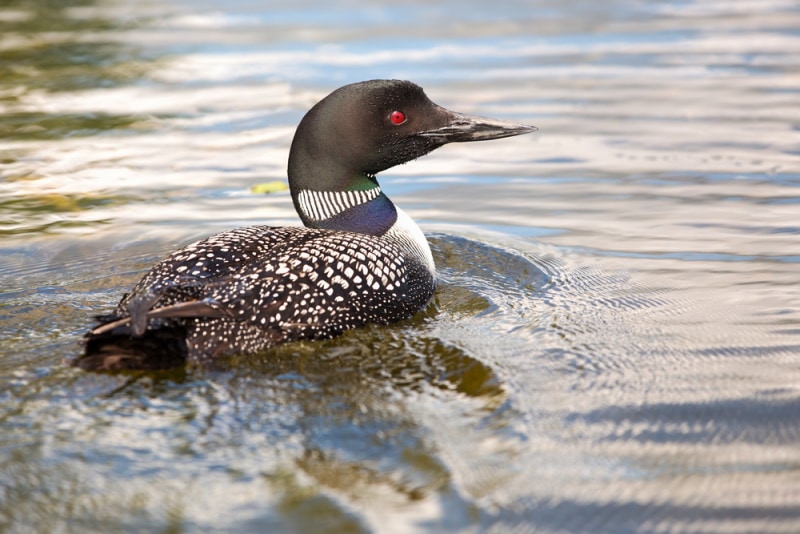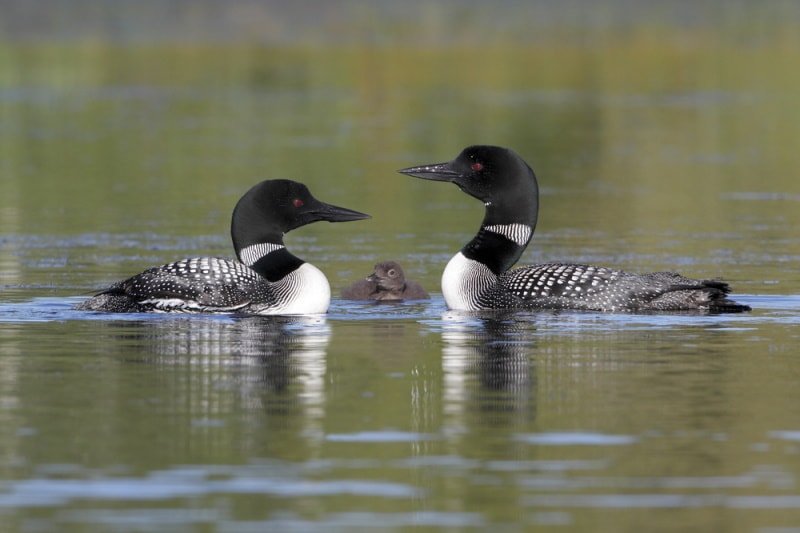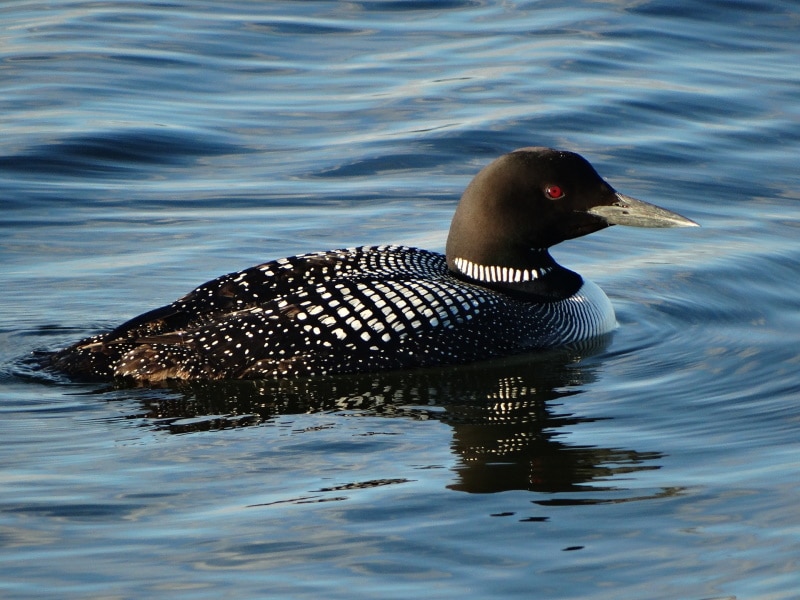Where Do Loons Go in the Winter? The Interesting Answer!
Last Updated on

If you have especially visited New Hampshire to witness loons in winter, you probably wonder where they go when it gets cold. Do loons migrate on colder days? Yes, loons travel in winter, but they don’t go too far.
These black and white birds with unique red eyes are primarily seen in the oceanic regions in winter. They travel to coastal ocean waters from Northern lakes. Those living in Western Canada or Alaska move to the Pacific Coast. Similarly, loons belonging to Eastern Canada migrate toward the Atlantic Coast.
But how far do they go, and why do they even have to migrate? Let’s find answers to all such questions in this post.

The Typical Migration Route for Loons
Loons prefer sticking to their favorite habitats in summer. They spend most of their time swimming in lakes, being very loud, and catching fish from underwater. So, if you visit a nearby lake in northern woods, you’ll be delighted by their chorus or loud calls.
When it gets colder, Common Loons look for quiet coastal waters to stay close to the shore. They are medium-distance birds migrating from northern lakes toward coastal ocean waters. The typical migration route for loons varies depending on the region they live in.
Loons from Alaska and Western Canada travel to the Pacific Coast, passing from the Aleutian Islands (Alaska) to Baja Peninsula (Mexico). On the other hand, loons living in the Great Lakes area move to the Florida coasts or the Gulf of Mexico. Meanwhile, the birds living in Eastern Canada travel to the Atlantic Coast.

Migration of Loons in Winters
Biologists studied the loon’s migratory behavior in England and New Hampshire in winter. The Loon Preservation Committee conducted banding and satellite studies to discover where and why loons migrate in the freezing temperature of New Hampshire. They also studied whether these birds return to their natural habitat after winter or not.
As soon as the temperature in the city dropped, the loons were seen spending their winters on the Atlantic Coast. The exact location of their migration is though mysterious.
Loons are banded birds, so it’s pretty tricky to identify them through the ocean waters. Yet, the researchers identified less than 40 loons on the ocean during the winter with the help of photographers and scientists.
To conclude, loons spend their winters along the Atlantic coast, primarily from Northern Jericho Bay in Maine to Southern Cape May in New Jersey.
Do Loons Return?
Many people wonder if loons migrate back in the spring. One report suggests that these birds do return to their breeding lake when the weather becomes favorable. However, the time is mainly around the spring.
The other loons soon follow them back and start preparing for the nesting season. So, if you’re living in New Hampshire, you’re likely to see these beautiful birds swimming in your nearest lakes as the ice melts. It also indicates that sunnier days are just around the corner.

Why Do Loons Migrate in the Winter?
The biologists explored the reason loons migrate in the winter. Loons don’t travel because they want to. Instead, they are forced to do it.
Loons are large birds with heavy bodies. Their feet are big, similar to an airplane, so they have to run a little to take off. If you ever saw a loon running on water, you’d know how awkward it looks. They run across the surface of the water for about a quarter of a mile to gather optimum speed for the flight.
In winter, the lakes are usually frozen or covered with ice. That prevents loons from running to take off, trapping them in the water for the entire season.
Loons move toward the safe lakes in southern regions. If they opt for any lakes that don’t freeze, they could be living alongside alligators or in warm or shallow water bodies. Such places can cause hunting and diving problems for the birds.
How Do Loons Migrate on Colder Days?
Loons generally travel in large flocks a few months after their chicks hatch. They wait for about 2–3 months after their black and white feathers turn brownish-gray.
Parent birds also wait for their young to develop flight feathers strong enough to allow them to fly. During this period, the chicks learn how to survive on their own. Once done, adult and young loons fly toward the ocean.
The biologists also found that the chicks don’t prefer leaving their birth lake until it starts to freeze. The real reason behind it is unknown. They also don’t know how the young ones know where to travel to meet their parents or visit favorable places.
Loon chicks don’t return to their original birthplace unless they turn 3–4 years old. They also don’t breed until they become 6–7 years old.

What Do Loons Face After Migrating to the Ocean?
When loons reach the ocean, they try to adapt to saltwater habitats. These birds are blessed with salt glands that naturally remove excess salt from the fish and water they eat throughout the day. They eliminate the salt through the ducks present in their beaks. The salt glands are located between the eyes in the bird’s skull.
The ocean offers deep, clear habitat for the birds to spend a few months. Once these birds become accustomed to the oceanic conditions, they make groups, ride the lake waves, and hunt in the water to keep their stomachs full. But life in the ocean isn’t easy for these birds. Loons have to go through molting and adjust to a different diet.
Late in the winter, the loon’s worn-out feathers are replaced by robust and long feathers that help them fly. Their dull coat also sheds and is replaced by a black and white breeding coat. This process is called “molting,” which continues for 2–3 weeks.
Loons also have to bear stormy weather, parasites, rough coastal waters, and marine pollution on the ocean.

Final Thoughts
Loons are widespread birds in England, North America, Alaska, and nearby regions. They are mostly seen swimming in lakes and diving their beaks underwater to catch smaller fish.
Many people see these birds as the symbol of spring and sunny days. So, do loons migrate in winter? Yes, these birds travel to the oceanic regions, typically towards the South. However, their direction may vary depending on the area they live in.
Biologists concluded that loons don’t migrate in winter because they have no other option. The lake water usually freezes in winter and may trap these birds the entire season. On the oceans, loons spend their time adjusting to the new conditions.
Featured Image Credit: Jim David, Shutterstock
About the Author Jeff Weishaupt
Jeff is a tech professional by day, writer, and amateur photographer by night. He's had the privilege of leading software teams for startups to the Fortune 100 over the past two decades. He currently works in the data privacy space. Jeff's amateur photography interests started in 2008 when he got his first DSLR camera, the Canon Rebel. Since then, he's taken tens of thousands of photos. His favorite handheld camera these days is his Google Pixel 6 XL. He loves taking photos of nature and his kids. In 2016, he bought his first drone, the Mavic Pro. Taking photos from the air is an amazing perspective, and he loves to take his drone while traveling.
Related Articles:
10 Types of Hummingbirds in Arkansas (With Pictures)
8 Types of Hummingbirds in Nebraska (With Pictures)
5 Types of Hummingbirds in Idaho (With Pictures)
3 Types of Hummingbirds in Mississippi (With Pictures)
8 Types of Hummingbirds in Kansas (With Pictures)
5 Types of Hummingbirds in West Virginia (With Pictures)
5 Types of Hummingbirds in Ohio (With Pictures)
Where Do Nuthatches Nest? Nuthatch Nesting Habits Explained
